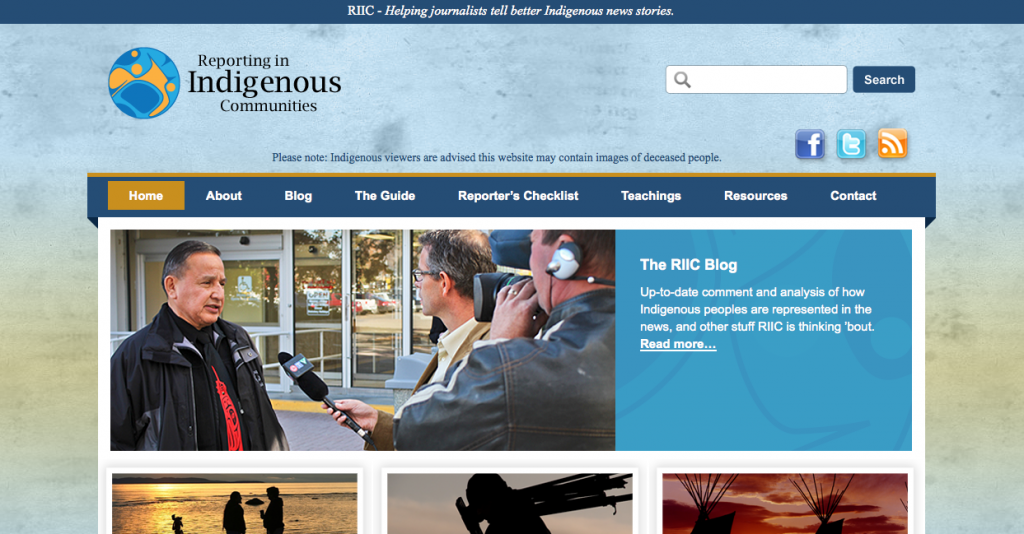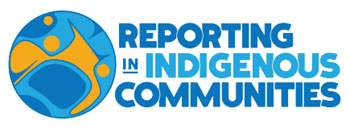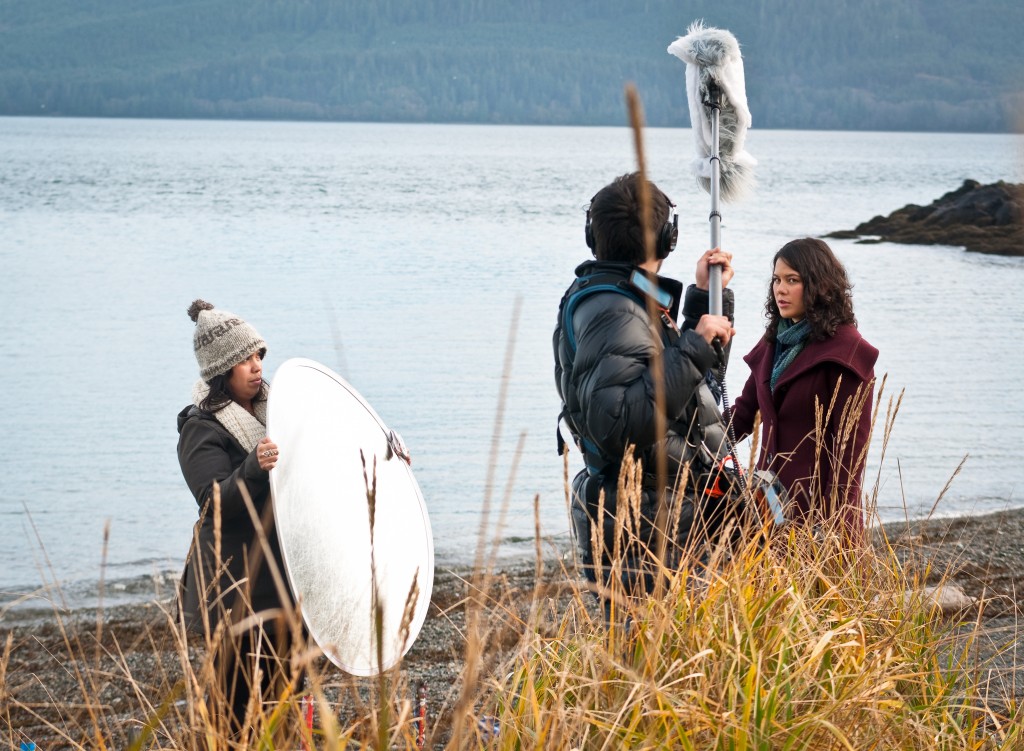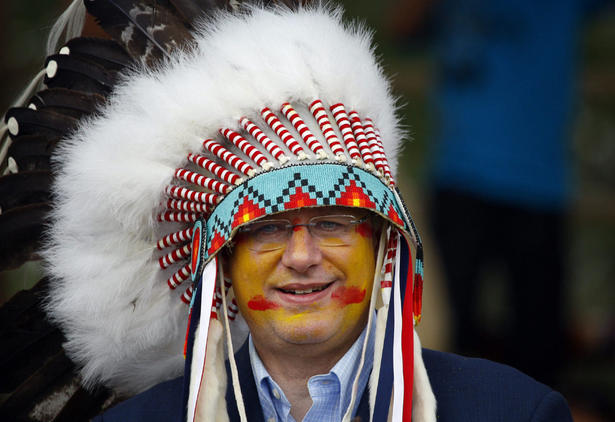12 Nov ‘Tis the season — term papers due soon!
RIIC is getting an awful lot of calls and emails from students recently, from Canada and the US. That time of the year. Big essays and assignments due. RIIC welcomes the calls — it’s encouraging to think a new generation of journalism students are thinking critically about news coverage of Aboriginal peoples. Thanks to journalism students Blair McBride and Corinne Ton Nu at University of Western Ontario, who are busy working on a paper on representation of Aboriginal peoples in the media, for taking time to provide RIIC with a transcript of our chat.
Duncan McCue: My general comment about coverage of Aboriginal people in the media is that…my observation is that Aboriginal people are underrepresented, and sometimes misrepresented. Let me unpack both of those statements for you. Statistically there is little question that Aboriginal people – in terms of content – are underrepresented. Aboriginal people compose about four percent of the population of Canada – there is no question that they are not represented in four percent of the content of the news media. We at CBC, for example, have done studies on the content with regard to visible minorities and at the moment its about three percent for Aboriginal people on CBC TV and radio. In the private broadcasters its much less than that, its about one percent. I actually think that given the importance of Aboriginal issues in terms of public policy in Canada, that there needs to be more than four percent, but if you use four percent as a starting point there is no question that Aboriginal people are underrepresented. Which means the Canadian public isn’t getting as much of the story of Aboriginal issues as they should be. They aren’t hearing the stories of Aboriginal people as often or as regularly as they should be. That’s a problem.
With regard to misrepresentation, the story frames that journalists in the mainstream media focus upon often paint a very two-dimensional picture of life in First Nations communities. I’m not suggesting that reporters get their facts wrong – that doesn’t happen very often – but the kinds of stories that we pursue tend to fall into very predictable frames and narratives of coverage. And they’re often very negative in their portrayal and thats a problem that has existed in the Canadian media for over a hundred years. The types of stories that we’re choosing to tell about First Nations communities are very very limited. And not necessarily painting a full portrait of life in Aboriginal communities. And that becomes problematic if the public’s only exposure to Aboriginal issues is through the news media. They end up getting a very two-dimensional image of Indians as being ‘problem people’ if you will- people that protest and cause direct action or people who always have their hands out looking for more money.
Corinne Ton Nu: And why would you say that portrayal is so negative?
DM: Why is the portrayal negative? In part its the way that media functions, its how we the news media determine what is newsworthy. With regard to Aboriginal people or anything else, we often look at problems and define that as being a news story and solutions are deemed to be less newsworthy. So thats partly the reason why there’s so much coverage of the “negative” when it comes to Aboriginal people. Also it has to do with the education of journalists with regard to Indigenous people, just what they bring to the newsroom, before they ever come to the newsroom and become news reporters. They may not know much about Aboriginal people that they’re reporting on. And so their scope of what is a story, what makes a story may be very limited to begin with. So they’re reproducing the stereotypes that they’ve grown up with which have been over the course of history – very negative.
CTN: Can you give me some specific examples of those stereotypes being reproduced in the media?
DM: A really simple example is a romantic image of Aboriginal people. There has been a fascination since settlers first started landing on the shores of Canada with the notion of the “romantic savage.” And so the beads and buckskin and feathers and Aboriginal people being close to nature and spiritual – all that kind of thing. We’re all very aware of the visual stereotypes that have continued to persist of Aboriginal people in those images. The plains Cree chief dressed in a headdress look is unfortunately ubiquitous both in terms of pop culture and news media. And with my students in my Reporting in Indigenous Communities class we could find examples of that “romantic savage” stereotype in the newspaper or in TV news almost every week of the course, popping up over and over again. There is no question that ceremonial regalia is very important to Aboriginal people but Indians don’t walk around in their headdresses 24/7. And a more accurate picture of a chief in the contemporary context is probably running through an airport with a blackberry on their ear than wearing a headdress. But we often see these kinds of stereotypical images of beads and buckskin and feathers when it comes to Indians.
CTN: You said there are a lot of stories missing that aren’t being reported. What are those stories?
DM: There are all kinds. We could sit here and talk all day about the kinds of stories that aren’t being reported in Indian country. [For example] recreation, sporting activities in First Nation communities, sexual abuse is a highly underreported story in Native communities, public service, First Nation bureaucracies and how they’re working on records and information management – thats one story I haven’t seen anyone report on. Indians use of technology, the Internet, Facebook and things like that. These are all kinds of stories about life in Aboriginal communities in the 21st century that we see very rarely reported in the mainstream media. But they’re important news stories and they need to be told.
CTN: Would you say that they’re not being told because of the news business or because of something else?
DM: In part, again, it goes back to that frame of what the news media interpret as being newsworthy. In part it has to do with a lack of knowledge of First Nation communities. Most mainstream newsrooms don’t have good connections to Aboriginal communities to know what’s going on. They don’t have an ear to the ground, if you will. In part it may also be that the media want to tell those stories but because of the historic distrust that has evolved between the media and Aboriginal people they can’t get access to those stories. I know lots of reporters who would like nothing better than to tell a story about how Indigenous people are using media but when they start making calls, people don’t return their calls or when they go to a community they get rebuffed – that kind of thing. They may not have the tools to be able to get past the barriers that reporters often face when we get into Indian country.
CTN: Could you give me some solutions on both sides – the Native community and non-Native community – to better represent Aboriginals in the media?
 DM: My best solution is that news reporters need to sit down and go to www.riic.ca and there’s all kinds of tips there. But that aside, what it means is building bridges with Aboriginal communities. That starts with taking them seriously and acting with respect when we go to Aboriginal communities. By increasing our content. If we start to increase Aboriginal content in our news programs then Aboriginal people will certainly acknowledge that and recognize that and start to be more receptive when we go to their communities to tell bad stories or good stories.
DM: My best solution is that news reporters need to sit down and go to www.riic.ca and there’s all kinds of tips there. But that aside, what it means is building bridges with Aboriginal communities. That starts with taking them seriously and acting with respect when we go to Aboriginal communities. By increasing our content. If we start to increase Aboriginal content in our news programs then Aboriginal people will certainly acknowledge that and recognize that and start to be more receptive when we go to their communities to tell bad stories or good stories.
CTN: Going back to your RIIC project – what were your main goals in developing that?
DM: To help journalists tell better news stories. It’s as simple as that. To offer some practical tips and advice. Really practical tips and advice. My idea was not to wag a finger at anybody and say “you’re doing bad things.” It is understanding that there are all kinds of challenges in reporting the news every day and that this was some wisdom and advice that myself and others have gathered over the years on how to do a better job on reporting in Indian country.
CTN: My last question is, how do you think that the Native media fares? How good are they at getting stories out? For example Windspeaker or ATPN?
DM: Not bad. Windspeaker, by design, has focussed very much on positive portrayals of Aboriginal people as a way to counteract the negative portrayals in the mainstream media. I think thats important and understandable but it’s also limited. I think it’s a journalists job to look at both the positive and the negative in First Nation communities. And at times I wish that Windspeaker would spend more time turning a critical eye toward some of the problems in our communities. APTN is doing a fantastic job of reaching out to First Nations and getting the news out there. I know experientially that when I go into a First Nations community APTN is on. Our people are watching APTN news and thats really important. APTN is unfortunately always struggling with resources and they’re trying to cover an entire country with not enough staff. What that has meant is that their coverage is sometimes limited and that their staff is overworked and sometimes under-experienced and so I am very confident that as APTN grows and matures that their coverage will only get better. I love the kinds of things that APTN investigates and I think that shows a real maturation of the network and I’m hoping that that will only get better as APTN journalists get more and more experienced.







